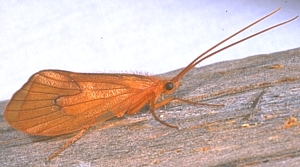|
|
ARTHROPODS:
Insects»
Spiders»
Centipedes»
Millipedes»
Sowbugs»
Harvestmen»
Mites
& Ticks»
Scorpions»
Identification
Tips»
About
the Critter Files»
Links» |
|
|
|
 |
CADDISFLIES
Critter
Files/Insects/Caddisflies
By Blake Newton
University of Kentucky Department of Entomology |
| |
|
| |
| TAXONOMY |
KINGDOM: Animalia
| PHYLUM: Arthropoda | CLASS: Insecta | ORDER: Trichoptera (caddisflies) |
| |
| Other
Names: caddisworms, trichopterans |
| |
WHAT
IS A CADDISFLY?
LIFE CYCLE
ECOLOGY
PEST STATUS
COMMON KENTUCKY CADDISFLIES
COLLECTING & PHOTOGRAPHY
CADDISFLY FACTS
MYTHS, LEGENDS, AND FOLKLORE |
| |
| WHAT
IS A CADDISFLY? |
|
Like all insects, caddisflies
have 6 legs, 2 antennae, and 3 body parts. Adult caddisflies
resemble moths, with hairy wings and long antennae, but caddisflies
do not have the long siphoning mouthparts that butterflies and moths
have. Caddisflies hold their wings tent-like over their bodies
when they are not flying.
Like stoneflies,
mayflies, and dobsonflies,
immature caddisflies are aquatic, living in streams and lakes. Caddisfly
larvae look similar to the larvae of mayflies, aquatic beetles,
and other aquatic insects, but can usually be distinguished by the
presence of a "case." Most caddisfly larvae construct
and live in a protective case made from small pebbles, twigs, or
other debris. The larvae build these cases using silk produced
from glands in their moths.

Typical Adult
Caddisfly (R. Bessin, 2004)
|
|
| SIZE:
Body length of larvae up to 1 1/2" long; adults up to 1".
|
| |
| LIFE
CYCLE |
|
Caddisflies
have complete metamorphosis. After hatching from eggs, young
caddisflies live underwater for a few months to several years, depending
on the species, before finding a hiding place to pupate. The
pupal stage lasts for the winter and early spring, after which the
winged-adult caddisflies emerge. The adults typically live
for about a month, just long enough to mate and lay eggs. Adults
usually stay close to the water, and adult females lay eggs on or
in the water (females of some species will dive underwater to lay
eggs). Some females will lay up to 800 eggs. |
| |
| ECOLOGY |
|
Like many
aquatic insects, caddisflies
live most of their lives in the larval stage, often 1 or 2 years.
All caddisfly larvae are aquatic, and most are found under
rocks in fast-running streams. Most caddisflies construct
protective, tube-shaped homes from small pebbles, pieces of wood,
and other particles. Caddisfly larvae use many different feeding
strategies, depending on the species. Some are predators who
feed on other small aquatic organisms. Others are "scrapers"
who scrape algae from the surfaces of underwater rocks. Some
species, called "net-spinners," construct a silken net
and hold it in front of their case, capturing particles of food
from the water as it flows by.
Caddisfly larvae are
an important part of stream ecosystems, where they help control
algae populations and provide food for fish and other creatures.
In healthy streams, caddisflies are usually very common and
their cases are found by the hundreds under rocks and logs. Unfortunately,
many streams in Kentucky are polluted with sediment or have low
oxygen levels and cannot support caddisfly populations.
|
| |
| PEST
STATUS |
|
Caddisflies
are not considered pests.
|
| |
| COMMON
KENTUCKY CADDISFLIES |
|
|
CASE-MAKING
CADDISFLIES
Most Kentucky caddisflies
are "case makers." Their larvae use silk to make
cases of pebbles and other aquatic particles. In clean, healthy
streams, they are very common under rocks and logs. There
are several dozen species of case-making caddisflies in Kentucky.
Common case-making families include Hydropsychidae, Lepidostomatidae,
Leptoceridae, and Limnephilidae. |
| |
 Typical case-making
caddisfly larvae (B. Newton, 2002)
Typical case-making
caddisfly larvae (B. Newton, 2002) |
|
|
|
FREE-LIVING
CADDISFLIES
A few species of caddisfly
larvae do not construct cases. Most of these species are predators.
Free-living caddisflies are not as commonly found as
case-making caddisflies. Some free-living caddisfly larvae
grow to nearly 1 1/2" long. Free-living caddisflies are
sometimes called "primitive caddisflies" and belong to
the family Rhyacophilidae. Many species, like the one pictured
below, are called "green caddisflies." |
| |
 Free-living caddisfly
larva (B. Newton, 2002)
Free-living caddisfly
larva (B. Newton, 2002) |
|
| |
| COLLECTING
& PHOTOGRAPHY |
|
Caddisfly adults are
difficult to find because they are only around for a few weeks each
year. Look on rocks and logs near streams in the spring and
early summer. Caddisfly larvae can usually be found under
rocks year round in clean, fast-flowing streams. Adults and
larvae are typically slow-moving, making them good subjects for
photographs.
|
| |
| MYTHS
- LEGENDS - FOLKLORE |
|
Do you know any myths,
legends, or folklore about caddisflies? If you do, let us
know!
|
Original document: 24 March 2005
Last updated: 24 March 2005
Photos courtesy R. Bessin and B. Newton, University of Kentucky
The Kentucky Critter
Files are maintained by Blake Newton, Department of Entomology, University
of Kentucky.
Contact: blaken@uky.edu
|
|

